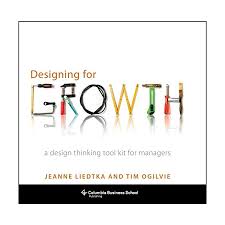Design Thinking for Growth: A White Paper
Author: Liedtka, Joanne
Introduction
Design thinking, a human-centered approach to problem-solving, has gained significant traction in recent years. This white paper explores the application of design thinking to drive organizational growth, focusing on the methodologies, benefits, and challenges associated with this approach.
Understanding Design Thinking
Design thinking is a non-linear process that emphasizes empathy, ideation, experimentation, and prototyping. It involves:
- Empathy: Understanding the needs, desires, and behaviors of users.
- Conducting user interviews and surveys.
- Observing user behavior in their natural environments.
- Creating user personas to represent different user segments.
- Ideation: Generating a wide range of creative solutions.
- Brainstorming techniques such as mind mapping and SCAMPER.
- Using creativity-enhancing exercises like role-playing and visualization.
- Encouraging diverse perspectives and collaboration.
- Experimentation: Prototyping and testing ideas to gather feedback.
- Creating low-fidelity prototypes to quickly test concepts.
- Conducting user testing to evaluate usability and effectiveness.
- Iterating on prototypes based on feedback.
- Prototyping: Creating tangible representations of ideas to evaluate their effectiveness.
- Building physical or digital prototypes.
- Using rapid prototyping methods like 3D printing or wireframing.
- Involving users in the prototyping process.
The Role of Design Thinking in Growth
Design thinking can contribute to organizational growth in several ways:
- Innovation: Fostering a culture of innovation by encouraging creative problem-solving.
- Generating new product and service ideas.
- Improving existing offerings.
- Identifying new market opportunities.
- Customer Centricity: Prioritizing customer needs and preferences in product and service development.
- Building stronger relationships with customers.
- Increasing customer satisfaction and loyalty.
- Reducing customer churn.
- Efficiency: Streamlining processes and reducing waste through user-centered design.
- Identifying inefficiencies in workflows.
- Improving user experience.
- Reducing costs and increasing productivity.
- Competitive Advantage: Differentiating from competitors by offering unique and valuable solutions.
- Creating products and services that meet unmet customer needs.
- Building a strong brand reputation.
- Attracting and retaining top talent.
Design Thinking Methodology
The design thinking process typically follows these stages:
- Empathize: Understand the users' needs, pain points, and motivations.
- Conduct user research to gather insights.
- Create user personas to represent different user segments.
- Develop empathy maps to visualize users' thoughts, feelings, and actions.
- Define: Clearly articulate the problem to be solved.
- Create a problem statement that is specific, measurable, achievable, relevant, and time-bound (SMART).
- Identify the root causes of the problem.
- Define the desired outcome or solution.
- Ideate: Generate a diverse range of potential solutions.
- Use brainstorming techniques to generate a large number of ideas.
- Encourage wild and unconventional thinking.
- Combine and refine ideas to create more innovative solutions.
- Prototype: Create tangible representations of selected ideas.
- Build low-fidelity prototypes to quickly test concepts.
- Involve users in the prototyping process to gather feedback.
- Iterate on prototypes based on feedback.
- Test: Evaluate prototypes with users to gather feedback.
- Conduct user testing to assess usability and effectiveness.
- Identify areas for improvement.
- Gather quantitative and qualitative data.
- Iterate: Refine and improve solutions based on feedback.
- Make changes to prototypes based on user insights.
- Repeat the testing and iteration process until a satisfactory solution is achieved.
Challenges and Considerations
While design thinking offers significant benefits, it also presents challenges:
- Resistance to Change: Overcoming resistance to new ways of working.
- Communicate the benefits of design thinking to stakeholders.
- Involve employees in the design thinking process.
- Provide training and support to help employees adopt new approaches.
- Lack of Resources: Allocating sufficient time, budget, and talent.
- Prioritize design thinking projects based on strategic importance.
- Allocate resources effectively to support the design thinking process.
- Consider outsourcing design thinking activities if necessary.
- Measuring Success: Quantifying the impact of design thinking on growth.
- Define key performance indicators (KPIs) to measure the success of design thinking initiatives.
- Track metrics such as customer satisfaction, revenue growth, and innovation rates.
- Use case studies to demonstrate the impact of design thinking.
Case Studies
- Company A: How design thinking led to a breakthrough product innovation.
- Identify the specific product or service that was developed using design thinking.
- Describe the design thinking process and the key steps involved.
- Discuss the impact of the innovation on the company's growth and market position.
- Company B: The role of design thinking in improving customer satisfaction.
- Explain how design thinking was used to understand customer needs and preferences.
- Describe the changes made to products or services based on customer insights.
- Quantify the improvement in customer satisfaction as a result of design thinking.
- Company C: Overcoming challenges and achieving success with design thinking.
- Identify the specific challenges faced by the company.
- Discuss how design thinking was used to address these challenges.
- Describe the outcomes and benefits of the design thinking initiative.
Conclusion
Design thinking is a powerful tool for driving organizational growth. By focusing on empathy, ideation, experimentation, and prototyping, organizations can develop innovative solutions, improve customer satisfaction, and gain a competitive advantage. By addressing the challenges and considering the best practices outlined in this white paper, organizations can successfully implement design thinking and reap its rewards.
References
- Liedtka, J. (2018). Design Thinking for Innovation: A Practical Guide for Managers. Routledge.
- Brown, T. (2008). Change by Design: The Transformative Power of Design Thinking. HarperBusiness.
- IDEO. (2013). IDEO Design Thinking Toolkit.
- Stanford University, d.school.
Note: This is a basic outline for a white paper on design thinking for growth. You may want to expand on certain sections, include additional case studies, or address specific challenges and best practices. To explore further, contact ias-research.com.



